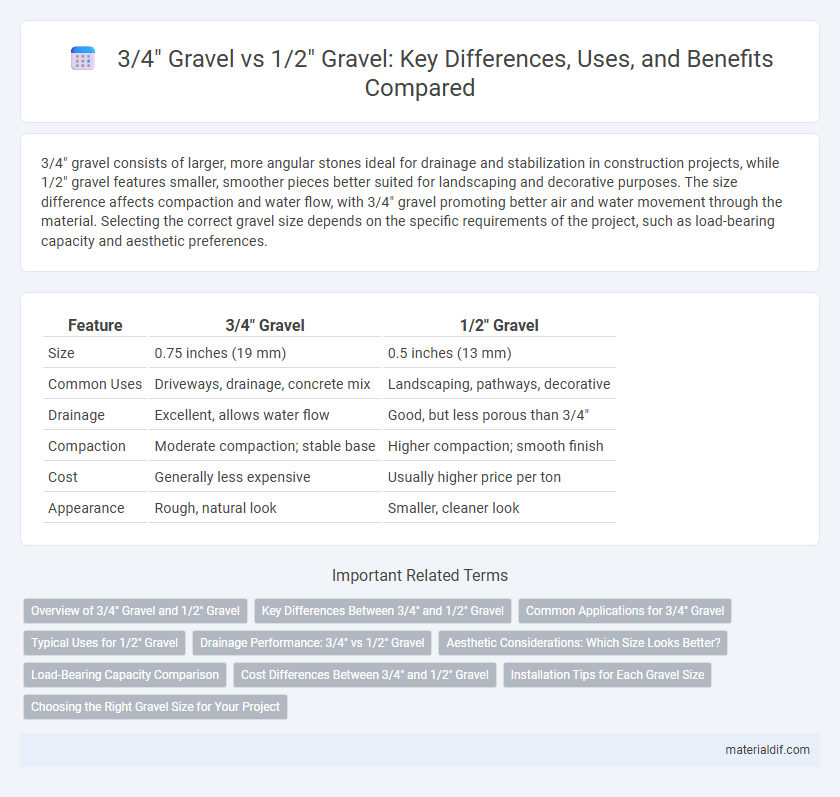3/4" gravel consists of larger, more angular stones ideal for drainage and stabilization in construction projects, while 1/2" gravel features smaller, smoother pieces better suited for landscaping and decorative purposes. The size difference affects compaction and water flow, with 3/4" gravel promoting better air and water movement through the material. Selecting the correct gravel size depends on the specific requirements of the project, such as load-bearing capacity and aesthetic preferences.
Table of Comparison
| Feature | 3/4" Gravel | 1/2" Gravel |
|---|---|---|
| Size | 0.75 inches (19 mm) | 0.5 inches (13 mm) |
| Common Uses | Driveways, drainage, concrete mix | Landscaping, pathways, decorative |
| Drainage | Excellent, allows water flow | Good, but less porous than 3/4" |
| Compaction | Moderate compaction; stable base | Higher compaction; smooth finish |
| Cost | Generally less expensive | Usually higher price per ton |
| Appearance | Rough, natural look | Smaller, cleaner look |
Overview of 3/4" Gravel and 1/2" Gravel
3/4" gravel consists of larger, angular rocks typically used for driveways, drainage, and construction projects requiring strong structural support, while 1/2" gravel features smaller, more rounded stones ideal for landscaping, walkways, and decorative purposes. The size difference affects compaction and drainage, with 3/4" gravel offering better load-bearing capacity and 1/2" gravel providing smoother, more compact surfaces. Both types contribute to erosion control and soil stabilization but are selected based on specific project needs and aesthetic preferences.
Key Differences Between 3/4" and 1/2" Gravel
3/4" gravel features larger, more angular stones ideal for drainage and structural stability in construction and landscaping, while 1/2" gravel consists of smaller, more compact particles suited for finer applications like driveways and pathways. The size difference impacts permeability, with 3/4" gravel allowing better water flow compared to the denser, less permeable 1/2" gravel. Choosing between them depends on the project's load-bearing requirements and desired surface texture.
Common Applications for 3/4" Gravel
3/4" gravel is commonly used for driveways, walkways, and drainage systems due to its larger size, which provides better compaction and stability compared to 1/2" gravel. Its angular shape allows for improved interlocking, making it ideal for construction bases and erosion control. In contrast, 1/2" gravel is typically preferred for decorative landscaping or top dressing where finer texture is desired.
Typical Uses for 1/2" Gravel
1/2" gravel is commonly used for drainage systems, walkways, and as a base layer for pavers due to its smaller size and better compaction ability. This size allows improved water flow and stability, making it ideal for French drains, driveways, and garden beds. Compared to 3/4" gravel, 1/2" gravel provides a smoother surface suitable for settings requiring finer materials and enhanced support.
Drainage Performance: 3/4" vs 1/2" Gravel
3/4" gravel offers superior drainage performance compared to 1/2" gravel due to its larger particle size, which allows water to flow more freely and reduces the risk of clogging. The increased void space in 3/4" gravel creates better aeration and prevents water accumulation, making it ideal for drainage systems and septic leach fields. In contrast, 1/2" gravel compacts more tightly, slowing water flow and potentially causing drainage issues in high-moisture environments.
Aesthetic Considerations: Which Size Looks Better?
3/4" gravel offers a more rugged and natural look, often preferred for driveways and pathways due to its larger, more prominent stones that create texture and depth. 1/2" gravel presents a finer, smoother appearance, ideal for decorative landscaping and garden beds where a polished, uniform look is desired. Aesthetic preferences depend on the desired visual impact, with 3/4" gravel emphasizing boldness and 1/2" gravel enhancing subtle elegance.
Load-Bearing Capacity Comparison
3/4" gravel exhibits a higher load-bearing capacity compared to 1/2" gravel due to its larger particle size and reduced compaction potential, making it ideal for heavy-duty construction projects and road base layers. The increased void space in 1/2" gravel leads to lower stability and more settlement under load, which restricts its use to lighter applications such as landscaping and drainage systems. Engineering studies highlight that 3/4" gravel distributes weight more effectively, reducing stress on subgrades and enhancing structural integrity.
Cost Differences Between 3/4" and 1/2" Gravel
3/4" gravel generally costs less per ton compared to 1/2" gravel due to its larger size requiring less processing and screening. The price difference typically ranges from 10% to 20%, influenced by local availability and transportation costs. Choosing 3/4" gravel can provide a more economical option for large-scale projects, while 1/2" gravel, often preferred for finer finishes, may carry a premium due to its increased sorting and handling requirements.
Installation Tips for Each Gravel Size
3/4" gravel provides better drainage and is ideal for driveways and heavy traffic areas, requiring a compacted base and proper edging during installation to prevent spreading. 1/2" gravel works well for pathways and decorative purposes, demanding a finer base and more frequent leveling to maintain an even surface. Both sizes benefit from a geotextile fabric to inhibit weed growth and improve stability.
Choosing the Right Gravel Size for Your Project
Choosing the right gravel size is essential for proper drainage, stability, and aesthetic appeal in landscaping or construction projects. 3/4" gravel provides better compaction and support for driveways or heavy-duty applications, while 1/2" gravel offers a smoother surface ideal for pathways or decorative uses. Understanding project requirements and load-bearing needs ensures optimal performance and longevity of the gravel installation.
3/4" Gravel vs 1/2" Gravel Infographic

 materialdif.com
materialdif.com